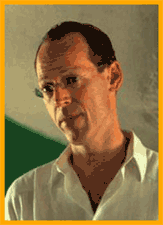After a year in Haiti, Farmer felt at home. He had encountered horrible living conditions, appalling sanitation, hunger, and disease at every turn, but he loved the Haitians and he loved his new country. Farmer was fascinated by Haitian history, which centered around the class struggle between the rich and the poor. Haitian culture seemed, to him, to have a life and creativity all its own; hardly typical for a country that had been under the control of other nations for so long.

Dr. Farmer looking quizzical. |
Unlike the other American physicians who came to do work in Haiti, Farmer could not imagine returning to the States while there was so much yet to do. He had dreams for Haiti - Farmer had traveled the country in hopes of finding a hospital that would provide equal health care for all and train Haitians to treat other Haitians. Instead, he found some hospitals with American doctors and unlimited resources and others with inadequate supplies and barely any personnel. Farmer longed to change this. He wished to one day build his own hospital on the Central Plateau that would offer care to anyone who needed it - a hospital that would do everything within its capacity to ensure the health of a patient, one that would function in spite of Haiti's political or social situation. Farmer knew that public health was incontrovertibly tied to social justice, and that only treatment would not be enough. Political and economic injustice had been the cause of suffering, disease, and poverty in Haiti, and it was something that Farmer felt an overwhelming desire to change.
In Haiti, Farmer also met a bright young British volunteer named Ophelia Dahl, who was working for Eye Care Haiti in Mirebalais. The two became good friends and before long, she shared Farmer's vision for human rights, social justice, and healthcare in a country rife with political unease. At the time, Farmer was juggling work in Haiti and studies at Harvard Medical School. For the first two years of medical school, he would fly to Boston in time to take exams and perform labs, then return immediately to his patients in Haiti. During this time, he and Ophelia also witnessed the terrible political violence that arose from rule under Haiti's military juntas. One instance stood out in particular. Paul and Ophelia had been returning from Port-au-Prince, and were caught in a riot. Political demonstrations had shaken the capital city after the fall of Francois Duvalier or "Baby Doc", one of Haiti's most notorious dictators. As shots rang out, a mob of demonstrators surrounded Paul and Ophelia's car, the only car in the mass of people. Despite Ophelia's pleas and the evident danger, Farmer made several trips downtown and back to bring injured civilians to safety. This would not be their last encounter with the government and most definitely not their most dangerous one. The fall of Duvalier did, however, open discussions among Haitians about topics that had previously been prohibited. Farmer was asked whether diseases were caused by the germs, then whether terrible sanitary conditions were the result of a negligent government.
Soon after, Paul and Ophelia teamed up with Jim Yong Kim, a Harvard anthropology student, Todd McCormack, Paul's friend from college, and Thomas White, the owner of a successful construction company. Thus, Partners In Health, a public charity to support their work in Haiti, was born. Tom White became the primary donor and soon, PIH had an office in Cambridge and was making plans to set up a Zanmi Lasante (Creole for Partners In Health), their health and social justice program in Haiti.

